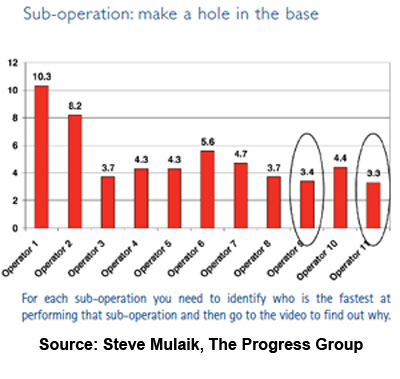Video Observation and Analysis
 Mulaik notes that part of the problem companies have is that most have significantly downgraded the number of industrial engineers on their staffs over the past decade or more. This is especially true in distribution, where the number of companies with full-time, on-site engineers has dropped dramatically. Mulaik notes that part of the problem companies have is that most have significantly downgraded the number of industrial engineers on their staffs over the past decade or more. This is especially true in distribution, where the number of companies with full-time, on-site engineers has dropped dramatically.
As a result, there is almost inherently less of a focus today on process analysis and improvement. That can be compOunded by various labor reporting systems that can sometimes drive supervisors to spend more time looking at numbers than really working with operators on how to better do the job (though Labor Management System providers will argue that such "coaching" is a core part of a total program.)
A critical point, Mulaik says, is that in reality, it is the methods that workers use in distribution and light manufacturing that actually explain most of the differences in productivity, not motivation or skill level, as is usually assumed.
It takes real analysis to get at potential productivity gains because "Large gains in productivity are achieved not through finding two or three things associated with a process that each saves 10%, but by finding many small things that each save 2% to 3%," Mulaik adds.
With his crown engineering approach, Mulaik suggests videotaping a large number of workers each doing the same job, and analyzing the process each worker uses for what typically is a multi-step process.
For example, The Progress Group recently worked with one home decor products manufacturer that had some light assembly operations. The 30-40 second assembly process actually consisted of 10 sub-operations that each took only a few seconds. They videotapes each workers, and then analyzed performance for each sub-process.
The results were surprising.
First, there were substantial differences in performance across each operator for a given sub-process, as shown in the graphic below.

Second, these differences between the performance of specific workers on a sub-process varied by worker and sub-process. In other words, it was not always the same workers who were superior for each sub-process. The leaders varied - depending on the method each used for that sub-process.
When you add up these differences of just a few seconds or even less across all the tasks, workers, and time, the opportunity for total improvement was substantial.
"Such nearly sub-second differences go
unnoticed everywhere," Mulaik says.
So, The Progress Group studied the best performers for each sub-process to understand what it was they were doing differently. As a result, it was able to identify the fastest approach to each sub-process - a series of "preferred methods" - that will maximize total productivity of the full process, often with increases of 20-30%.
In many cases, especially for a series of fairly short sub-steps, use of video analysis is key, Mulaik believes.
Video allows slow motion and repeat viewing, whereas "an untrained eye, without the aid of video, might never see these little 0.5 to 2-second differences in method used by different operators," Mulaik says.
In total, this can take many hours of analysis. Mulaik says the cost of this can be reduced by using qualified offshore resources trained in how to do the analysis and log the data.
But it can be done on the relative cheap in-house as well, hiring part-time staff to shoot the video and others to do the analysis.
Interestingly, Mulaik says the biggest benefits often come from when there are a large number of relatively short sub-steps to complete a full process cycle. Long sub-steps - say 20 minutes - tend not to offer the same level of productivity opportunity.
He also told SCDigest that even after the new methods have been defined, "you are still fighting muscle memory" in how people do their jobs. He also thinks companies should take a look at adding incentive pay into this equation.
"I think incentives are definitely one of that variables that need to be fully explored when you do this," Mulaik told us. "It’s hard to get everyone to do this on their own. We sill find people dropping out and often times moving on because they just cant bring themselves to take on the "new way".
All told, "crowd engineering" seems like a low cost, high impact way to improve distribution and manufacturing performance.
What's your reaction to the "crowd engineering" concept? How does it differ, improve - or not - traditional "preferred methods" development? Have you used a similar approach? Let us know your thoughts at the Feedback button below.
SCDigest is Twittering!
Follow us now at https://twitter.com/scdigest |